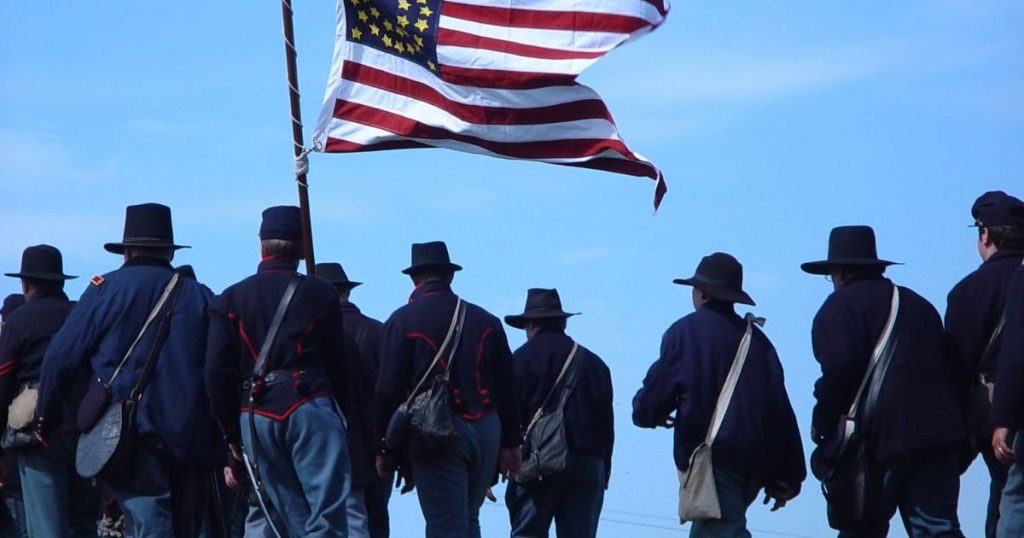eft survived is preserved in a corner of George Mason University in Northern Virginia, a success story that came about through a six-year collaboration between a Civil War roundtable and the school.
A dedication ceremony on October 7 for the redoubt, built by Confederate troops near Fairfax in 1861, celebrated the effort to protect and interpret the site. The fort, about 80 feet in diameter, saw no action during the war, but was an important early warning outpost for both rebels and yanks occupying the site.
Attempts to save the site in the early 1990s and early 2000s came to nothing. Concerned about his condition the Bull Run Civil War Roundtable (BRCWRT) approached history department leaders in late 2015 and early 2016.
The conversation started, and students in a Civil War and Reconstruction class at George Mason have since toured the site — which is near a campus parking lot — with round table members as guides .
In 2019, the campus grounds department removed four large trees that threatened the redoubt’s structural integrity and cleared the grounds and surrounding area of vegetative undergrowth and saplings.
The redoubt became fully visible for the first time in more than 75 years.
Groundskeepers have since cleared access path routes and installed two interpretive markers created by the George Mason-BRCWRT team.
“Education and preservation are the core missions of the Bull Run Civil War Round Table — and central to our purpose — to learn about and learn from the history of the American Civil War,” said Blake Myers, president of the preservation service at the BRCWRT, at the event.”The preservation and interpretation of this site is a great example of those two missions in action.”
The redoubt was built by Colonel Robert Rodes’ 5th Alabama Infantry, Ewell’s Brigade, in June 1861. It was built on high ground along two well-traveled thoroughfares – today’s Braddock Road and Route 123 (Ox Road).
It is difficult to know how many men were deployed at the redoubt at any given time. It was used as an observation post and command post for the units/soldiers manning picket posts along the trenches to the east or west (depending on which side controlled this part of Virginia) of the redoubt.
The redoubt at Farr’s Cross Roads was one of several fortifications built to control and discourage federal troops from marching to Manassas Junction from Washington and Alexandria, Virginia.
Dust raised by federal troops in July 1861 signaled a federal advance. When Confederate troops withdrew to their main line of defense along the Bull Run on July 17, the site was occupied by Union troops commanded by Brig. General Irvin McDowell, according to the roundtable. The Battle of Manassas (Bull Run), the first major battle of the conflict, took place just days later.
The hastily built fort changed hands during the war, but was largely in the hands of Union troops, including the 16th New York, 1st New Jersey, and 2nd Massachusetts Infantry . While it once had a parapet up to 6 feet high, most of the ring is currently half that height.
Significant commercial and residential development in suburban Washington has erased most of the earthen structures erected on either side, so it’s a minor miracle the redoubt survives, as it is bounded on all sides by asphalt and buildings.
A BRCWRT article a few years ago described the project and the collaboration with George Mason.
“While the construction of the Mason Inn and car park and expansion of student car park K have reduced the overall size of the site and may have wiped out some of the earthworks, the redoubt still stands and is in remarkably good condition. ”
Myers told the Civil War Picket in an email that a 50-foot stretch of a line of trenches, believed to have been built by Union troops, survives west of campus along Braddock Road.
| Remains of the redoubt lie behind this marker on the George Mason campus (BRCWRT) |
Among university officials who worked with the BRCWRT to preserve the site was history professor Brian Platt, who brought the redoubt’s attention to the administration. In prepared remarks at the ceremony, he used the term “Fairfaxed” to describe the rampant development in the area.
“My first thought at the time was how lucky we were to have this site here on campus, and not on private property, or in a real estate developer’s viewfinder,” Platt said.
“After all, if there was a conservation project taking place somewhere in a highly developed suburban landscape – if a location prevented it from being ‘Fairfaxed’ – it would certainly happen at a university – a place with a scientific interest in studying and preserving of our historical and cultural heritage.”
Fairfax County was home to numerous Civil War fortifications and features, a legacy reinforced by the discovery of a cedar clad highway near George Mason in 2014. The so-called “corduroy road” is believed to date back to the Civil War.
The Round Table had GMU alumnus Nathan Loda draw a picture of the area as it appeared in 1861.
“The sketch represents our informed view of what the entrenchment, crossroads and Farr estate looked like in June 1861,” Myers said. “We have not yet found any historical photos or sketches of the redoubt or the area…what we know about the redoubt is taken from unit history, the official records, letters from soldiers, etc. ”
Myers told the audience on Oct. 7 that it was a day to enjoy what has been collectively achieved, but that there is more work ahead.
We continue to work with GMU to pursue additional preservation and interpretation on the site – remains of a stone building on the site, site overlooking corduroy road discoveries in 2014 and 2015, remains of the farm road/trench line on the site, enhanced interpretation using virtual and augmented reality technologies,” he wrote de Picket.


